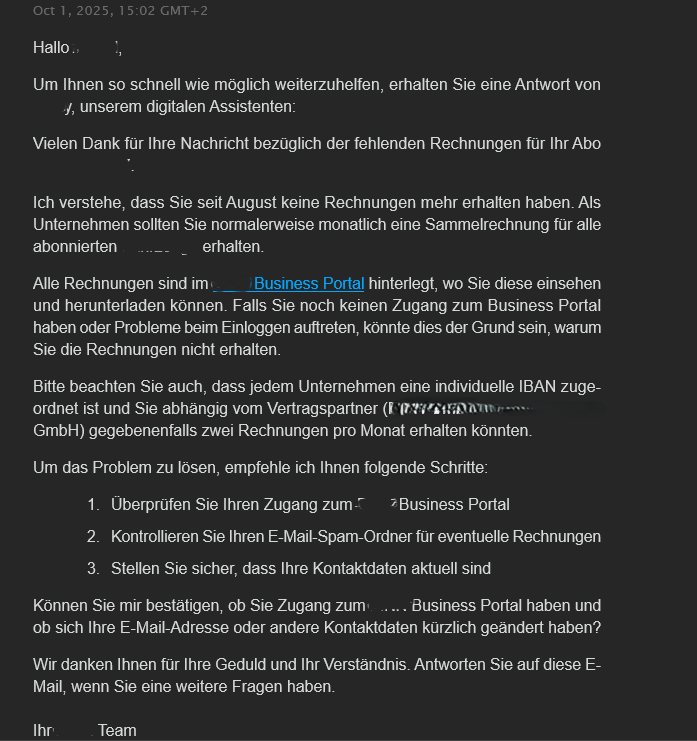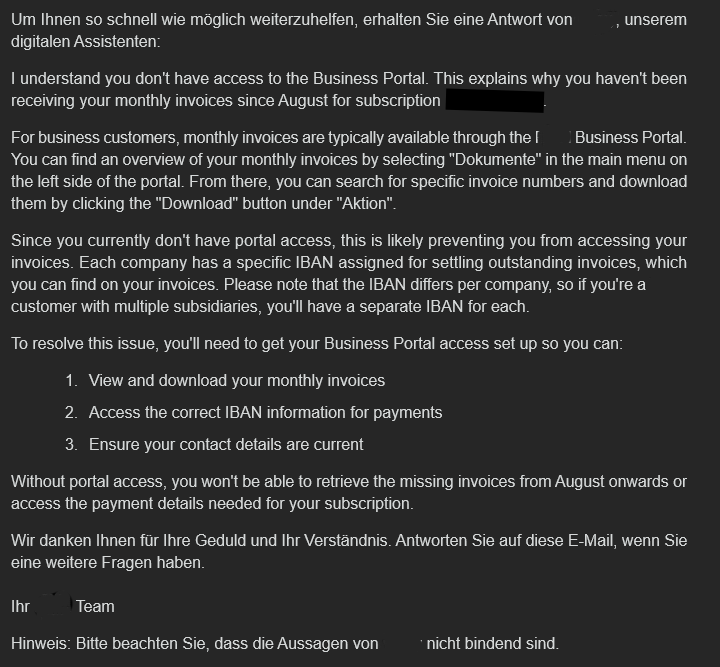This month, I had a simple problem: I wasn’t receiving invoices from a company I subscribe to.
One email should have solved it. Instead, I got trapped in a customer service AI agents powered „Groundhog Day.“ It is a perfect, real-world parable of why 95% of enterprise AI projects are failing.
The timeline
Email 1:
„I’m not receiving any invoices for subscription xxxx.“
Their AI Response:
A 200+ word message explaining:
- I should check the Business Portal
- All invoices are stored there
- I might need to check my spam folder
- My contact details should be up to date
Then it asked: „Can you confirm whether you have access to the Business Portal?“

Email 2:
I responded: „I don’t have access to the Business Portal.“
Their AI Response:
201 words explaining:
- Why I need Business Portal access
- What I could do if I had portal access
- How to use the portal once I’m inside
What it didn’t include:
- How to GET access
- Any way to actually solve my problem

It took eight separate attempts before the bot either gave up or escalated to a human.
This wasn’t a case of limited ROI or an immature feature. Despite the company’s claim of a 75 % deflection rate, the system was effectively blocking a paying customer. It consumed compute, AI, and cloud resources to stop someone from reporting a problem or completing a payment — a textbook example of negative ROI hidden behind a success metric.
Why This Matters
This isn’t just one company’s bad chatbot. This is a pattern.
As we’ve built AI agents for production environments, we’ve seen this same failure mode everywhere: AI that appears helpful while being completely useless.
The responses are:
- Professional ✓
- Well-formatted ✓
- Solving nothing ✗
The real cost:
- Two weeks without any progress
- Three separate email attempts & support tickets instead of one
- Eventual human intervention anyway
- Customer frustration
All because someone deployed AI that can generate text, but can’t solve problems.
What Went Wrong: A Five-Layer Autopsy
After building production AI systems, I can pinpoint exactly where this failed. It’s not one bug – it’s architectural failure across five critical layers.
Let me break it down using the Cognitive Agentic Architecture (CAA) framework we use at Arti:
Layer 1: Context – The AI Has Goldfish Memory
What happened:
The AI treated each email as completely isolated. It couldn’t understand that my second message was a direct response to ITS OWN suggestion.
Email 1: „Check the portal“
Email 2: „I can’t access the portal“
AI: [Explains what the portal does]
Zero connection between the two.
What was missing:
Context isn’t just conversation history – it’s structured understanding.
This is what we mean by typed, versioned context – not raw strings, not isolated messages, but structured data that persists.
The fix:
Build a Context Layer that transforms conversations into structured understanding. When I said „I don’t have portal access,“ the system should have updated its context model.
Layer 2: Behavior – No Brain, Just Templates
What happened:
The AI had no decision-making capability. It matched the keyword „portal“ and regurgitated a template. There was no reasoning about:
– Why I mentioned the portal
– What should happen next
– Whether repeating itself would help
What was missing:
The Behavior Layer is the „planner“ – it should create an explicit, inspectable execution plan based on the context.
The AI should reason about the problem, not just pattern-match keywords.
The fix:
Separate reasoning from response generation. The Behavior Layer decides what needs to happen. Other layers execute it.
Layer 3: Execution – All Talk, No Action
What happened:
The AI could only generate text. It couldn’t:
- Check my access status in their system
- Retrieve my invoices from the billing database
- Create an access request
- Attach files to the email
It could only explain what I should do – if I had the access I don’t have.
What was missing:
This is where „Execution-first AI“ matters. Chatbots answer questions. Enterprises need work done.
These are deterministic workflows & tool calls – not suggestions. Not explanations. Actual execution.
The fix:
Define tools as contracts with typed interfaces. Every action the AI references should map to a real function it can call.
Layer 4: State – Perpetual Amnesia
What happened:
The AI forgot everything between emails:
- What it had already suggested
- What I had already confirmed
- How many times this had failed
- That escalation was overdue
What was missing:
State is the persistent memory that tracks progress across sessions.
After Email 1, the state should have been:
"ticket_status": "awaiting_customer_response", "suggested_actions": ["check_portal"], "attempts": 1, "last_updated": "2024-09-28"
After Email 2, it should have updated to:
"ticket_status": "escalation_required", "blocking_issue": "no_portal_access", "suggested_actions_failed": ["check_portal"], "attempts": 2, "escalation_triggered": true, "last_updated": "2024-10-10"
This enables multi-step, resumable workflows. The system should recognize: „I already suggested this, customer confirmed they can’t do it, time to try something else.“
The fix:
Use structured, persistent agent state. Not session variables. Not loose dictionaries. Explicit state machines that track progress and trigger escalations.
Layer 5: Collaboration – No Escape Hatch
What happened:
The AI was stuck in a loop with no mechanism to get help. No threshold for „I’ve failed twice, a human should handle this.“
What was missing:
After the second failed attempt, the Collaboration Layer should have:
- Flagged for human review within 4 hours
- Notified the onboarding team to contact me directly
- Set an SLA for resolution
- Provided me with direct contact info for urgent issues
This is human-in-loop by design – not as a last resort when everything breaks, but as a core architectural component.
The fix:
Build collaboration hooks from day one:
- Escalation thresholds (attempts, time, complexity)
- Approval workflows for sensitive actions
- Human supervision for high-stakes decisions
- Override capabilities when AI is uncertain
Observability: Nobody Could See It Breaking
Somewhere in their company, nobody knew:
- That I’d contacted them twice about the same issue
- That their AI was stuck in a loop
- That escalation was needed
- Which component was failing
CAA requires: Full tracing and metrics. Every decision, every tool call, every state transition should be observable. If you can’t debug it, you can’t trust it in production.
What Good Looks Like
A real AI system would have understood the context, realized I had no access, automatically initiated the onboarding process, and attached my missing invoices directly to the reply.
One email. Problem solved.
The Hidden Pattern
This failure isn’t unique to customer service. We see it everywhere AI touches production:
- HR bots that explain benefits policies but can’t enroll you
- IT support that troubleshoots in circles without accessing your actual system
- Sales assistants that qualify leads but can’t schedule meetings
- Compliance tools that flag issues but can’t explain which rule was violated
The pattern is always the same:
✓ Sounds intelligent
✓ Looks professional
✗ Solves nothing
Why?
Because teams optimize for:
- Response speed
- Deflection rate (% of tickets „handled“ without human)
- Tone and formatting
- Coverage (% of queries that get a response)
They should optimize for:
- Resolution rate (did it fix the problem?)
- Escalation intelligence (did it know when to ask for help?)
- Contextual awareness (did it understand the full situation?)
- Actionability (can the customer do something concrete with this?)
Why This Matters Now
At Munich AI Nexus, our community of senior practitioners confirmed it: the biggest blockers are ‚context‘ and ‚data chaos.‘
This case study is a perfect example. The company had all the data. Their AI just couldn’t use it. You can’t automate what you don’t understand. And agents without a real architecture are just expensive hallucinations.
AI reliability isn’t just about better models — it’s about aligning system incentives so that helping the customer isn’t treated as a cost.
Stop Diagnosing, Start Building.
This is Not a Prompt Problem. It’s an Architecture Problem.
The era of AI demos is over. The market is tired of expensive theater. The „Second Wave“ of AI is about building reliable, auditable, and stateful systems that deliver measurable ROI.
If you are tired of living in your own „Groundhog Day“ loop, it’s time for a different approach.
Our 2-week „Friction Audit“ is the definitive first step. It is a rapid, data-driven diagnostic that moves you from „admiring the problem“ to having a concrete, ROI-backed architectural blueprint.

